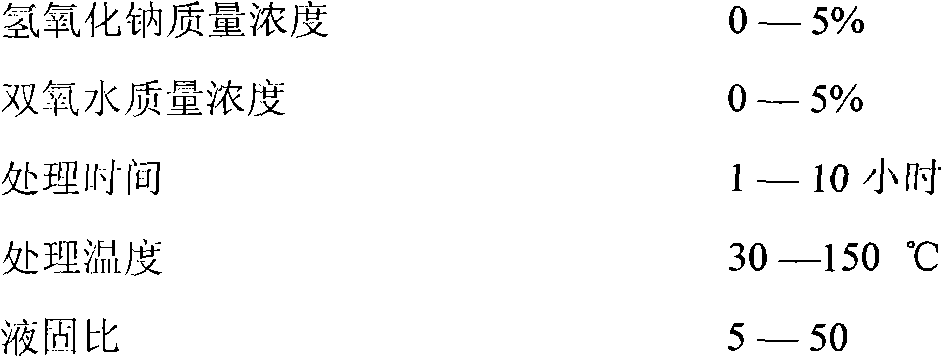Method for pre-treating lignocellulose raw material and for preparing reducing sugar by conversion
A lignocellulosic pretreatment technology, which is applied in sugar production, fructose production, sugar production, etc., can solve the problems of high pretreatment cost, high pollution, and the lack of establishment of cellulose raw material pretreatment system integration and supporting systems, etc. question
- Summary
- Abstract
- Description
- Claims
- Application Information
AI Technical Summary
Problems solved by technology
Method used
Image
Examples
Embodiment 1-5
[0020] Prepare 500ml of 1.0% aqueous sodium hydroxide solution and pour it into a 1000ml flask. Weigh 25g of sawdust, and then add 3.75ml of 30% hydrogen peroxide solution. Start the stirrer, adjust the temperature of the water bath to 70°C, and set the treatment reaction time to 1, 2, 3, 4 and 5 hours respectively. See Examples 1, 2, 3, 4 and 5 of Table 1 for the effect of the treated samples.
Embodiment 6-10
[0022] Prepare 500ml of 1.0% aqueous sodium hydroxide solution and pour it into a 1000ml flask. Weigh 25g of sawdust, and then add 3.75ml of 30% hydrogen peroxide solution. Start the stirrer, process the reaction for 3 hours, and set the temperature of the water bath at 50, 60, 70, 80 and 90°C, respectively. See Table 2, Examples 6, 7, 8, 9 and 10 for the effect of the treated samples.
Embodiment 11-15
[0024] Prepare 500ml of hydrogen peroxide solution with a mass fraction of 0.225%, and pour it into a 1000ml flask. Weigh 25g of sawdust and add it. Start the stirrer, adjust the temperature of the water bath to 70°C, and treat the reaction for 3 hours, and set the concentration of sodium hydroxide to 0.6%, 0.8%, 1.0%, 1.2%, and 1.4% respectively. See Table 3, Examples 11, 12, 13, 14 and 15 for the effect of the treated samples.
PUM
 Login to View More
Login to View More Abstract
Description
Claims
Application Information
 Login to View More
Login to View More - R&D
- Intellectual Property
- Life Sciences
- Materials
- Tech Scout
- Unparalleled Data Quality
- Higher Quality Content
- 60% Fewer Hallucinations
Browse by: Latest US Patents, China's latest patents, Technical Efficacy Thesaurus, Application Domain, Technology Topic, Popular Technical Reports.
© 2025 PatSnap. All rights reserved.Legal|Privacy policy|Modern Slavery Act Transparency Statement|Sitemap|About US| Contact US: help@patsnap.com



